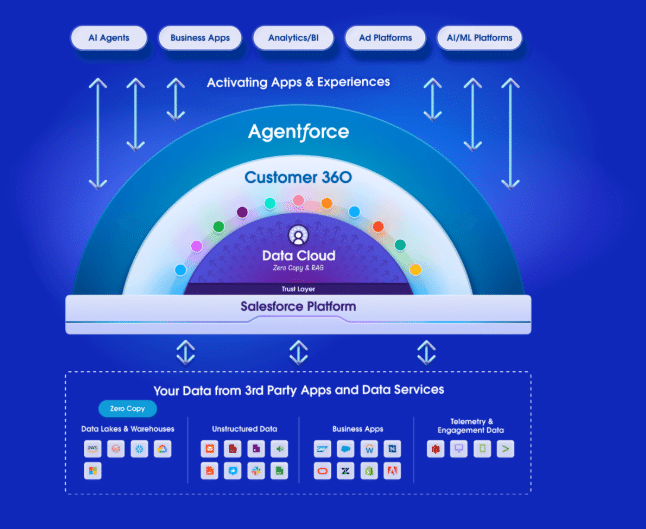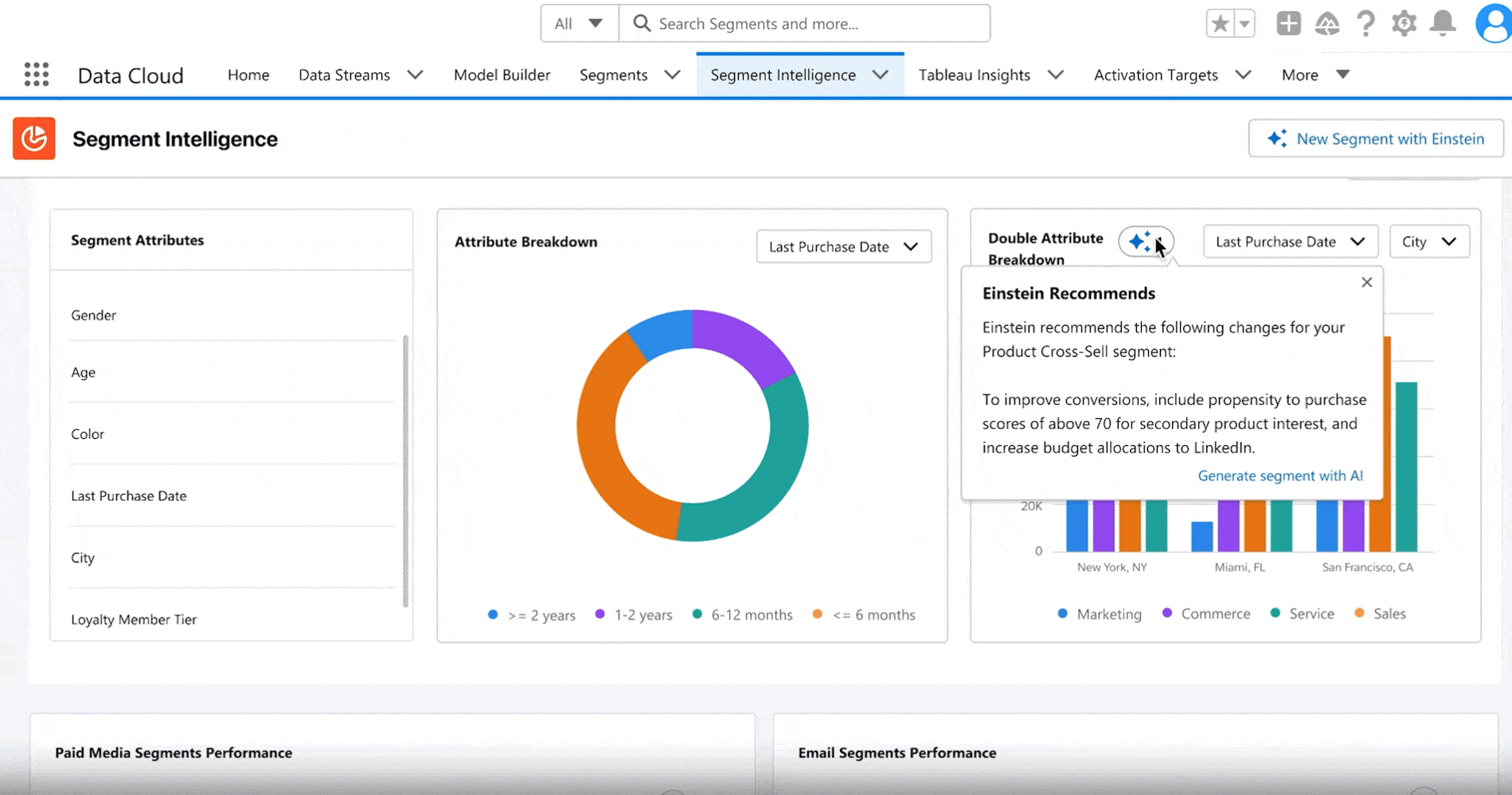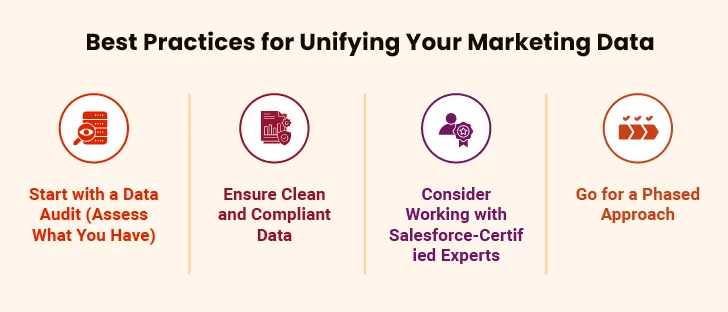“You can’t personalize what you can’t see.” Data is your superpower, but only as long as it is connected, clean, and complete. For most marketing teams, that’s far from reality. Data often lives in dozens of tools, campaigns are built on bits and pieces of information in the system, and building customer journeys feels more like guesswork than knowing for sure what will work.
Siloed data is not a new problem. It can often get in the way when you’re running a campaign or trying to send a personalized email. While the intention is to drive meaningful communication, the execution is often compromised by data chaos in your Salesforce ecosystem.

In this blog, you’ll see how marketing teams can break free from scattered data and build a unified, intelligent, and scalable marketing data strategy in Salesforce. You’ll learn why centralizing marketing data is necessary, and how Salesforce Marketing Cloud and Data Cloud bring everything into one single view. Of course, we’ll follow it up with the kind of impact this strategy will have on customer engagement and ROI. So, let’s dive in.
The Current State of Marketing Data
Over the past few years, marketing technology (Martech) stacks have swelled up. Some of the prime examples would be Google Ads, Meta, LinkedIn, HubSpot, Mailchimp, and Adobe to CRMs, social media schedulers, and data analytics dashboards. The ecosystem has become increasingly complex. On average, a marketing team now uses more than 12 different platforms just to run daily operations.
Each of these tools might give you valuable data, but what good is it if they aren’t integrated to give you a holistic view (or what people call “single source of truth”)? Eventually, you’ll be looking at:
- Data silos across paid, owned, and earned channels
- Fragmented data and disconnected campaign performance metrics
- Redundant, inconsistent, or outdated customer records
Now, when your Salesforce marketing data lives in silos, the entire marketing operation suffers. Here’s how:
- Poor targeting: Without a consolidated view, you’re basically basing your decisions on incomplete data and inaccurate customer profiles.
- Inconsistent messaging: There’s a high probability that your customers might receive contradictory messages across channels that may ruin your brand reputation.
- Delayed responses: It becomes almost impossible to react to real-time customer behavior patterns which limits your ability to engage at the right time.
- Inaccurate reporting: Measuring ROI and attribution becomes more of a guessing game.
Ultimately, fragmented data leads to poor experiences and lost opportunities. And given the current landscape very few companies would be actually willing to afford this risk.
Why the Need for a Unified Data Strategy?
A unified data strategy bridges your business goals with tech investments. It’s basically your blueprint to ensure that data is accessible, trustworthy, and ready to use across the Salesforce ecosystem. Let’s understand in detail.
For a Tailored Marketing Approach
Customers expect brands to know them…not just by name, but by behavior, context and preferences. They want to receive the right message, on the right channel, at the right time. And when that doesn’t happen, they notice it and often feel disconnected or undervalued. In fact, Salesforce says that 65% of customers expect brands to understand their changing needs and preferences, yet only 41% believe companies actually do it.
So, the critical question is: Is your data aligned with the needs of your customers?
A centralized data repository with a solid, unified data strategy will allow marketing teams to:
- Build a complete, 360-degree customer profile (or buyer persona)
- Leverage real-time personalization and automation
- Sync efforts across teams (from marketing to sales, service, and delivery)
- Make quick, confident decisions backed by the right data
For Meeting Changing Customer Expectations
Despite marketing teams working hard to meet evolving customer expectations, their effort might go in vain due to internal challenges that get in the way. They might struggle with:
- Customer data living in separate silo systems
- Teams operating on different KPIs/metrics and systems
- Poor marketing data integration and legacy systems slowing everything down
Hence, once again, as you can see, without a consolidated system and a strong data strategy to back up your marketing efforts, even the best-intended campaigns can miss the mark.
Thankfully, Salesforce has a solution for marketing teams to overcome all the pain points we discussed so far.
How Salesforce Solves the Data Chaos?
Salesforce provides a cohesive ecosystem that brings all your marketing data into one place, enabling you to automate processes, and deliver personalized experiences to your audiences. Let’s see how Salesforce’s platform offerings and capabilities are helping marketing teams make an impact while having full control of their data.
1. Salesforce Data Cloud (To Consolidate Data in Real Time)
Salesforce Data Cloud serves as the backbone for real-time customer data management. It pulls in data from multiple data points including third-party CRM systems, websites, mobile apps, and emails. By doing so, this platform creates a holistic customer profile enriched with read-to-use metadata. This comprehensive view empowers marketing teams to analyze customer behaviors and preferences in detail. Of course, these specific customer insights can be further used in different Salesforce applications for multiple purposes.
To help you understand better, this is the level where Data Cloud fits in the Salesforce ecosystem.

Source: Salesforce
Some of the most important features of Salesforce Data Cloud include:
- Streaming Data Integration: Data Cloud captures changes from core Salesforce systems in real time using the Change Data Capture (CDC) functionality. This ensures that customer profiles are always up to date.
- Vector Database Capabilities: It can seamlessly process unstructured data like PDFs, texts, and voicemails. And then convert them into structured formats for easy integration and analysis.
- AI-Ready Infrastructure: With built-in support for AI models (especially Einstein), the Data Cloud platform facilitates advanced analytics and personalized customer experiences.
2. Marketing Cloud (To Activate Data for Personalization)
Now that you have a centralized data system, i.e., you have access to all your data inside one platform, the next step is to use the data. Salesforce Marketing Cloud empowers marketing teams to design and execute personalized campaigns across multiple channels using the insights from Data Cloud.
Here are some of the most notable features of Marketing Cloud.
- Journey Builder: This tool allows for the creation of automated, multi-channel customer journeys, responding to real-time behaviors and preferences.
- Interaction Studio: This feature enables real-time personalization by analyzing customer interactions and delivering relevant content across web, email, and mobile platforms.
- Segmentation: Utilizing machine learning capabilities and data insights, Marketing Cloud can help you predict, and segment audiences based on their behavior patterns and choices, which is crucial in targeting the right customers.
- Einstein AI Integration: Marketing Cloud offers send-time optimization and personalized content recommendations using Einstein, making sure that your audience gets the right at the right time.
For better understanding, here’s a closer look at how Agentforce, Einstein, Data Cloud and Marketing Cloud come together to help you create smart customer segments.

Source: Salesforce
As a sidenote, in the last couple of rollout cycles, Salesforce made a huge impact when they launched Agentforce. With a new branding, Agentforce has been a more popular and preferred go-to option for many marketing teams, especially when it comes to personalization (or building an agentic enterprise in that sense). It’ll be interesting to see what new features and updates the Salesforce Winter ‘26 Release brings to the table by the end of this quarter.
3. Customer 360 (To Create a Unified Customer Experience)
The Customer 360 platform acts as the unifying layer across Salesforce’s various clouds and applications. It basically ensures that every department, including marketing, sales, service, and commerce, has access to a consistent and comprehensive view of customer data. Some of the most noteworthy features of this platform are:
- Cross-Departmental Visibility: This means seamless data sharing across teams so that customer interactions are informed, consistent, and cohesive.
- Integrated Workflows: It facilitates the creation of unified processes that span multiple departments, enhancing operational efficiency.
- Unified Customer View: It gives a 360-degree view of each customer, empowering businesses to provide personalized, timely, and relevant experiences that strengthen customer relationships.
This approach is particularly beneficial in complex customer journeys, where interactions span across multiple touchpoints and departments.
How to Master AI & Personalization in Salesforce Marketing Cloud
4. Additional Salesforce Capabilities That Come Built-in
Salesforce’s open architecture allows for seamless integration with various marketing systems, including:
- Ad platforms: Offers native integration capabilities with Meta, Google Ads, LinkedIn, TikTok, and more for custom audience syncing, retargeting, and performance tracking.
- Email & communication tools: Integrates with Outlook, Gmail, Slack, WhatsApp, and others to unify customer communications across channels.
- Web & app analytics: Provides ready-to-use data from Google Analytics, Adobe Analytics, and even first-party behavioral data for better journey design and personalization.
- Data connectors: Salesforce connects to virtually any system using MuleSoft and native APIs—ERP, DMPs, loyalty platforms, and even data lakes—to centralize and activate customer data.
This integration layer ensures that your entire marketing technology stack operates as a single source of truth.
Furthermore, by leveraging the consolidated data from Data Cloud and the engagement tools in Marketing Cloud, Salesforce enables real-time audience activation.
- Behavioral Triggers: Actions such as website visits or email clicks can instantly initiate personalized marketing responses.
- Dynamic Content Delivery: Content adapts in real time based on customer interactions, ensuring relevance and increasing engagement.
- Automated Campaign Adjustments: Campaigns are easy to adjust on the fly based on real-time data insights, optimizing performance continuously.
Now, this takes us to our next section, where we’ll explore the benefits that tag along with streamlined Salesforce marketing data.
How Unified Marketing Data Is a Valuable Asset for Marketing Teams?
When data is consolidated, it becomes a catalyst for your marketing success. By leveraging the power of the Salesforce ecosystem, marketing teams can tap into a range of powerful benefits that go beyond just campaign management. They combine together to bring tangible value to marketing teams, directly impacting the bottom line, increasing customer loyalty, and enhancing team efficiency.
Here’s a breakdown of what truly becomes possible.
I. A Holistic View of Every Customer
At the heart of great marketing is understanding your customer (simply as a person). Salesforce’s unified data strategy enables you to take full advantage of:
- 360-Degree Profiles: With Salesforce Data Cloud and Customer 360, you get a full picture of your customers.
- Purchase history
- Browsing behavior
- Ad interactions
- Support tickets
- Survey responses
- Real-Time Identity Resolution: Salesforce automatically reconciles identities across platforms, merging known and anonymous data into unified profiles. This makes way for consistent, personalized messaging across every customer touchpoint.
- Cross-Functional Access: Data is available to all teams including marketing, sales, service, and commerce, enabling seamless collaboration and coordinated customer experiences.
- Advanced Segmentation: Use unified profiles to build highly specific audiences. For example, repeat buyers who browsed a certain category but didn’t convert.
- AI Optimization: Salesforce Einstein can suggest the best send times, subject lines, or content for each customer based on real-time data.
- Ad Spend Efficiency: By syncing CRM audiences with Google, Meta, or LinkedIn via Marketing Cloud Advertising, you can minimize on ad spends and increase relevance.
- Contextual Engagement: Data Cloud supports real-time streaming. This means when a customer clicks on a product in an email, it can trigger a personalized push notification or ad within seconds.
- Dynamic Content: Marketing Cloud’s Content Builder enables emails and landing pages to adapt in real time based on who is viewing them, using rules tied to CRM and behavioral data.
- Moment-Based Marketing: Rather than relying on batch sends, marketing teams can create “moments of engagement” based on real customer actions (like browsing a product, abandoning a cart, or interacting with a chatbot).
- Detailed Dashboards: With BI tools like Tableau, Marketing Cloud lets you create specific data dashboards that consolidate metrics across all channels (email, paid, social, web, and mobile), and reveal customer insights.
- Custom Attribution Models: Instead of relying on generic last-click models, Salesforce allows marketing teams to create custom attribution logic that reflects the actual buyer journey.
- Predictive Forecasting: Salesforce Einstein delivers detailed insights. It helps marketing teams predict, understand trends/patterns, and allocate budgets accordingly.
- What systems currently collect and store customer data?
- What types of data are being captured (behavioral, transactional, demographic)?
- Where are the redundancies, inconsistencies, and gaps?
- Which data sources are truly driving business value?
- Data Hygiene: Remove duplicates, correct inaccuracies, normalize formats (country codes, date fields), and validate contact details.
- Consent Management: Track and honor customer consent across all touchpoints—email, web, mobile, offline. Note that Salesforce Marketing Cloud integrates with Consent Management tools to ensure you’re always aligned with privacy laws.
- Data Governance: Define clear roles for data ownership and stewardship. Establish rules around who can access, modify, or export specific data.
- Strategic Alignment: Experts help align the platform’s capabilities with your specific marketing goals—from personalization to ROI tracking.
- Architecture Planning: They ensure scalable and secure integration with existing CRM, ad platforms, and third-party data sources.
- Customization: No two businesses are alike. Experts tailor your setup (segments, journeys, data models, reports) to your specific workflows.
- Training & Change Management: Your marketing teams are coached to adopt new tools, interpret dashboards, and use insights for day-to-day marketing decisions.
- Begin with one data source and one high impact use case (for example, abandoned cart recovery)
- Add more data streams and campaigns (for example, ad retargeting, onboarding journeys)
- Enable full customer 360 views, predictive analytics, and multi-channel personalization
You get everything in one place.
This complete visibility helps marketing teams stop relying on assumptions and start acting on evidence.
“Customer expectations are growing exponentially. If you can’t see the full picture, you can’t deliver the right experience.”
— Clara Shih, CEO of Salesforce AI
II. Improved Campaign ROI
Given our experience working with several enterprises around the globe, it’s not surprising that marketing teams are under immense pressure to show ROI. But, with siloed data, proving value becomes nearly impossible. When you consolidate your marketing data in Salesforce, you make way for smart choices and smarter decisions.
Here’s how:
III. Real-Time Personalization
Customers don’t just need personalized messages; they need it quick! While some marketing teams struggle with this aspect in their ongoing initiatives, winning teams rely on Salesforce marketing data to help them out. Here’s how:
Here’s how:
Additionally, Salesforce’s Einstein AI models can be trained to even predict the next best product or channel for each customer.
IV. Improved Decisions with Comprehensive Reports
By analyzing your data sets in Salesforce Data Cloud, you can generate reports that might come in handy for marketing teams. In fact, the reports can be further drilled down for specific insights which may prove to be beneficial. More importantly, you can make smart decisions quickly (you have real data to back them up). A small piece of information often leads to big wins, and we’re no stranger to this concept.
Many enterprises that adopt real-time reporting and predictive analytics through Salesforce platforms have seen massive improvements in forecasting accuracy.
Now, let’s see the best practices that marketing teams should follow.
Best Practices for Unifying Your Salesforce Marketing Data
While the benefits of unifying marketing data in Salesforce are clear, achieving them requires a strategic and thoughtful approach. Without the right foundation and technical know-how, no amount of quality data can deliver what marketing teams are after (ROI).
Here are the compiled best practices that marketing teams should prioritize to ensure that their data works for them.

1. Start with a Data Audit (Assess What You Have)
Before integrating or migrating anything, you must first understand your existing data landscape. A comprehensive data audit will help you answer important questions:
Start by mapping your entire marketing technology stack…email platforms, CRMs, ecommerce/payment systems, ad networks, analytics tools, mobile apps, and so on. From there, assess the quality, usability, and accessibility of each data set.
Consider using tools like Salesforce’s Data Cloud Discovery Assessment to evaluate your current readiness and identify opportunities for consolidation and enrichment. Apparently, this is the first and the most important step in laying a strong foundation for unifying your data.
2. Ensure Clean and Compliant Data
Your data is only valuable if it is accurate, up-to-date, and trustworthy. Also, your data needs to be in line with privacy regulations like GDPR, CCPA, etc. You must treat customer data with care. To ensure this, marketing teams can focus on:
The Salesforce’s Summer ‘25 release added privacy-aware data ingestion controls in Data Cloud, ensuring that only consented data is unified and activated. Clean and compliant data holds the key to improving customer trust and campaign performance.
3. Consider Working with Salesforce-Certified Experts
Salesforce may be a powerful platform, but your success depends on how well you implement it. When you’re implementing Salesforce, you’re basically undergoing digital transformation, nothing less. Hence, it makes sense to involve Salesforce-certified experts or consulting partners to make maximum impact. Here’s what they can help you with:
4. Go for a Phased Approach
Implementing everything at once is one of the biggest mistakes that many organizations make. It is impractical and risky. Instead, a phased approach following the agile methodology helps reduce complexity, mitigate risk, and generate value quickly. Here’s how:
Structure your implementation in agile sprints. Each sprint should focus on a clear use case, data connection, or campaign, with defined goals and measurable outcomes. Additionally, consider launching with pilot groups…either internal teams or select customer segments to test and validate before rolling out more broadly. This iterative approach ensures continuous learning, minimizes disruption, and enables faster time-to-value across all phases.
Final Thoughts: Bringing Order to Marketing Chaos
Marketing is now more about knowing your customers better than ever before and turning every piece of knowledge into action. And for that, your data needs to be centralized, accurate, and ready to use. Thanks to Salesforce’s capabilities, marketing teams can break down silos, integrate systems, and access the right tools to deliver personalized experiences and make smart decisions. Many companies are often not sure where to start. An experienced Salesforce consulting partner with expertise in Marketing Cloud can come in handy.
Salesforce From Data Cloud and Marketing Cloud to Customer 360 and Agentforce, every piece of the Salesforce ecosystem is like a jigsaw, which when put together, forms a detailed picture of your customers. Nevertheless, unified marketing data still remains the centerpiece of the jigsaw to leverage the true potential of the platform. Because when your data works together, your marketing does too.





